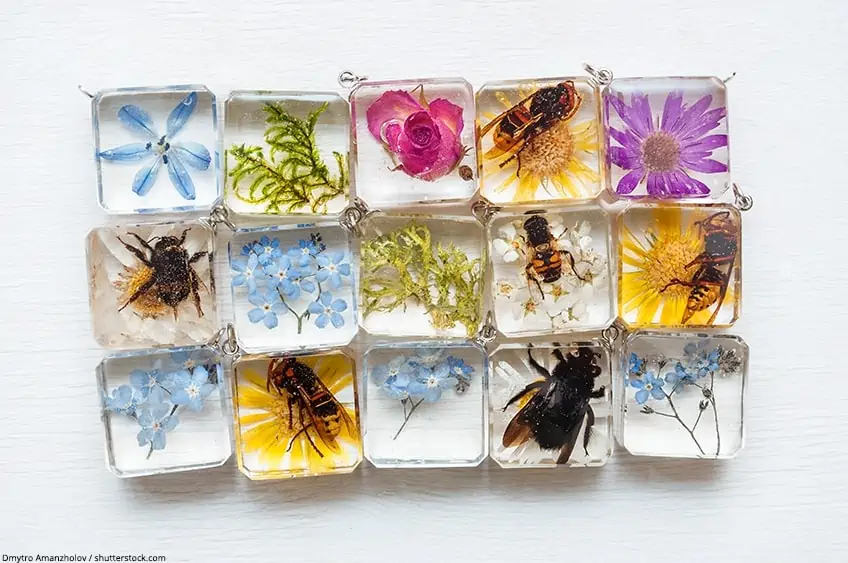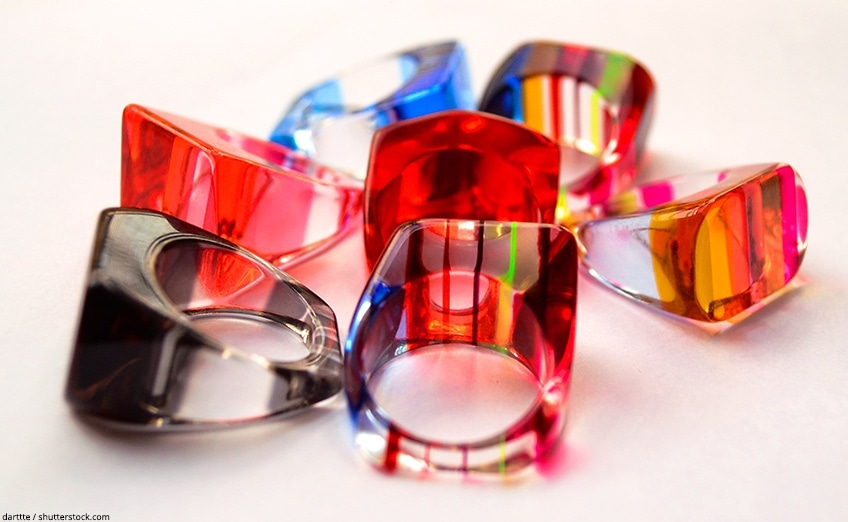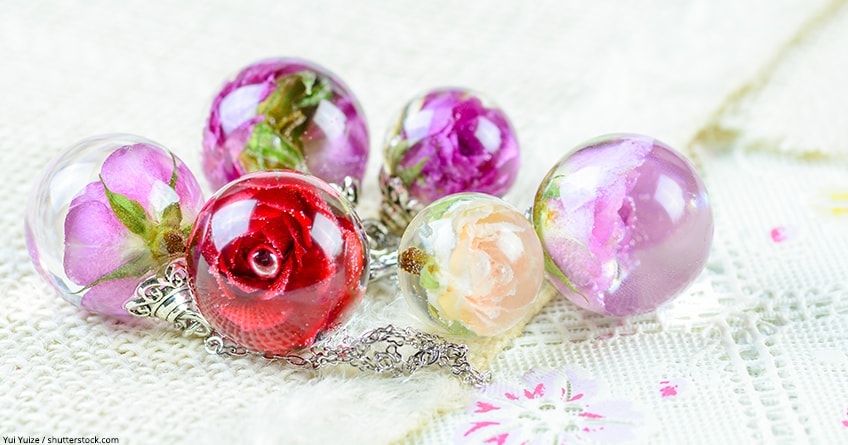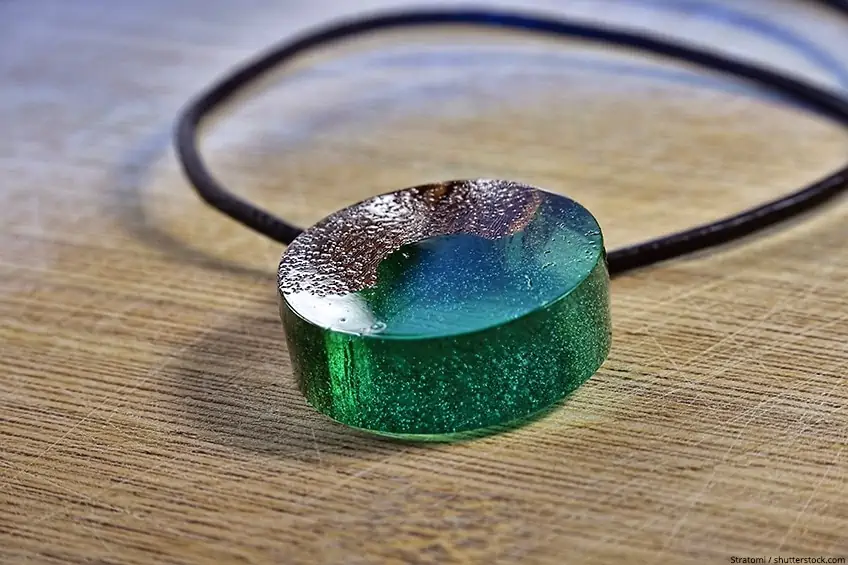How to make Resin Jewelry and the Best Jewelry Resin [Tutorial]
This post may contain affiliate links. We may earn a small commission from purchases made through them, at no additional cost to you. You help to support resin-expert.com
The list of materials that can be used to create beautiful jewelry or dreamlike accessories is almost endless. But hardly any other material is as versatile and can be processed as individually as epoxy resin. If the crystal-clear surface is in itself an absolute eye-catcher, you can conjure up unusual unique pieces with small, incorporated details such as pearls, stones or flowers. In the resin these elements set beautiful accents and remain forever. In the following article we will show you with many tips and tricks how you can easily create precious epoxy resin jewelry yourself.
Table of Contents
What Type of Resin Works for Resin Jewelry?
For the production of your individual pieces of epoxy jewelry, you have the choice between different resins: epoxy resin, UV resin, or polyester resin. All variants are available in a well-assorted hardware store, craft shop or in any case online. With epoxy resin and polyester resin the right mixing ratio is extremely important for an ideal result.
You should follow the manufacturer’s instructions on the package very carefully when mixing resin and hardener. The resin is often available in relatively large containers. The hardener, however, is often available in smaller bottles. The reason for this is that epoxy resin for molding casting must be mixed in unequal proportions.
Therefore, a measuring cup with a scale, which allows measuring to the nearest millimeter, is very helpful for mixing. A kitchen scale is also very useful for measuring. Alternatively, you can choose a synthetic resin with a 1:1 mixing ratio, where resin and hardener are used in equal parts, or you can opt for a UV resin.
Different Types of Resins
The biggest difference between epoxy resin and polyester resin lies in the duration of curing and in the appearance. As polyester resin is very robust and dries quickly, it is often used for mold parts such as profile plates, mold construction or in boat building. It is usually slightly cloudy when cured. Epoxy resin, on the other hand, with its crystal-clear appearance, is much better suited for processing into jewelry and accessories.
A very good alternative is UV resin. This cures within a few minutes using a UV lamp and no two components need to be mixed. A disadvantage is that the layers can only be cast very thinly. This is not so important when making jewelry, as these are usually small pieces.
Which Objects can be Placed into Resin?
There are no limits to creativity when selecting the elements to be cast in the resin. Flowers, stickers, pearls, stones, glitter, food or even real prepared insects – everything is possible. Sometimes it is advisable to test the effect of such an element in the resin before casting the actual object.
It is definitely easier to work with solid, compact but not too heavy elements, because they do not lose their shape in the epoxy resin. (e.g. small beads, glitter or mica flakes) These can also be mixed with the resin without any problems. Heavy objects such as crystals and small stones must be poured in between the individual resin layers, otherwise they would sink. Casting resin is low viscosity, i.e. very thin in consistency (in contrast to resin used for resin art).
Filigree objects such as natural materials or dried flowers must be placed in the still liquid resin with a lot of dexterity, otherwise they might appear as unsightly lumps in the resin. In this case it can be helpful to seal the elements with napkin glue beforehand.

Perfect Resin Jewelry Molds
There is a wide range of ready-to-use silicone molds so that you can start casting jewelry immediately. Especially in the jewelry sector, there is a large selection of molds – from earrings and pendants to finger rings or bracelets.
How to make Resin Jewelry
Epoxy Resin Casting Jewelry in Silicone Mold
- Once you have decided on a suitable jewelry silicone mold, it is very useful to estimate beforehand how much of the mixture is actually needed to fill the mold.
- Then mix only about half of the required amount and pour it into the mold. Optionally, the resin can be additionally colored after mixing.
- Objects which are very light can be positioned in the still liquid resin as already mentioned.
After this, the mixture should dry for at least 24 hours (or as long as recommended by your resin manufacturer) - Once the first layer has hardened, position larger and heavier objects that you want to cast. If necessary, you can fix them with a small amount of resin to prevent slipping.
After this has hardened, fill the rest of the mold with the epoxy resin and let it dry as recommended by the manufacturer.
Tip: Any air bubbles that may have formed in the resin can be removed by briefly (!) swiveling a hot air blow dryer or Bunsen burner over the material.
Remove the Resin Jewelry from Mold
Exact information on how long the resin you are using takes to cure completely can be found in the manufacturer’s instructions on the packaging. Please observe these during processing. With most synthetic resins which are suitable for epoxy resin jewelry, the casting is sufficiently hardened after approx. 48 hours to release it from the mold. Attention: Often rough or sharp edges form in the mold on the underside of the finished piece. Please take care not to injure yourself when removing the piece of jewelry.
Finishing of Epoxy Resin Jewelry
Any sharp edges can be easily removed with fine-grained sandpaper. If you have used conventional silicone molds, the finished resin jewelry often lacks the necessary shine due to the mold. With polishing paste and a soft cloth, you can achieve a crystal clear, shiny effect in a flash. Alternatively, the object can be finished with gloss varnish or crystal clear resin.
To learn more about Epoxy Resin sanding, please read our in-depth tutorial on how to wet sand resin
However, it is best to use polished silicone molds. These have an extremely smooth inner surface that gives your jewelry a perfectly even finish. This eliminates the need to finish the casting. Suitable silicone molds are available in a variety of designs. There is a wide range of different shapes for pendants, key rings, earrings, rings and bracelets.
To learn more about Epoxy Resin polishing, please read our in-depth tutorial on how to polish resin
For advanced Students: Cast Resin Jewelry with Wood
It is also possible to combine epoxy resin and wood for jewelry. This resin jewelry looks especially noble and valuable. Above all it is extremely individual. The procedure is completely different here. First a blank is cast from one (or more) suitable pieces of wood of your choice and resin with the help of a mostly rectangular silicone mold. Alternatively, you can also make the mold yourself.
The absolute supreme discipline is the production of epoxy resin jewelry combined with wood. These pieces of jewellery are very noble and timeless.
The pieces of wood are placed in the mold and the whole thing is then filled with resin. It is particularly effective if you work with dyed resin. This blank is removed from the mold after it has completely hardened. It is then cut into the desired shape or appearance and subsequently. This requires a little more craftsmanship than with conventional cast resin jewelry, but with a little practice it is not so difficult.
Common Setbacks With Resin Jewelry Making
Making resin jewelry has plenty of unique benefits, but it also involves a few setbacks. We have outlined a few challenges that many may face with making resin jewelry below, as well as answered some frequently asked questions on the topic.
Flowers Embedded in Resin May Not Last
Embedding flowers into the resin can provide a stunning effect, but it needs to be done properly. Make sure that the flowers get treated correctly before being set in the resin. Otherwise, flowers could fade or turn brown or yellow over some time.
The best way to avoid this would be to properly dry the flowers out and then treat them with an ultraviolet lacquer. If you want the flowers to still look fresh, you could even add a bit of paint that’s the same color as them. These processes are necessary for maintaining the shape and color of flowers before you embed them in resin.
Resin Jewelry Could Form Bubbles
When mixing the resin with the hardener, bubbles will form. These need to be removed in order to achieve a perfectly clear piece of resin jewelry. Bubbles can be removed using a degasser or pressure pot. While these items are the most efficient, they are also fairly expensive. If you are a beginner or don’t make resin jewelry often, then using a toothpick or blow torch can also help to get rid of the bubbles.
Resin Can Be Toxic
Before resin cures and it is still in a fluid form, it can produce potentially harmful fumes and odors. As soon as the resin cures, it does become non-toxic. For best safety measures, make sure that the resin is FDA approved for food safety, and does not contain any Bisphenol-A.
Whatever resin you are working with, make sure that you are in a well-ventilated space, and are taking proper protective measures. This includes wearing gloves and a respirator mask.
Resin Can Yellow
A major appeal of resin is that it cures to a durable, glossy, and clear finish. Unfortunately, this can turn yellow over time. Try to use a UV protected resin of the highest quality in order to avoid this. Adding a stabilizer can also help.
Making Resin Jewelry at Home
If you are interested in DIY and crafting, then making resin jewelry at home is a great idea. With some practice, it can be an easy and highly rewarding task. There is plenty of information on the subject available online and through books. However, the best way to produce quality pieces is through practice. Just remember to wear the proper protective gear.
Types of Resin Jewelry
- Earrings: Resin earrings can be made in different shapes and sizes, such as drops, rings or geometric shapes. Elements such as glitter or dried flowers can also be embedded.
- Pendants: resin pendants can be made in a variety of shapes and colors, such as hearts, flowers, animals, or abstract shapes. Items such as glitter, shells or beads can also be embedded.
- Rings: resin rings can be made in different sizes and shapes, such as a wide cocktail ring or a thin stacking ring. Elements such as color pigments or metallic foil can also be used to customize the ring.
- Bracelets: resin bracelets can be made as wide statement pieces or as thin, elegant bands. Elements such as dried flowers or small figurines can also be embedded.
- Cufflinks: resin cufflinks can be made in a variety of shapes, such as small squares or circles. Elements such as letters or numbers can also be embedded to create a personalized gift.
- Necklaces: resin necklaces can be made in different lengths and shapes, such as a choker or a long chain. Elements such as pendants or beads can also be embedded to complete the look.
Frequently Asked Questions
How to Make Resin Jewelry Using Dried Flowers?
You can either buy ready dried flowers or dry them yourself using silicate sand. Then fill a jewelry mold with a small amount of resin, place the flower in this, and cover the rest of the mold with more resin. Once the resin has fully cured, the flower jewelry can be used. Find a tutorial on our blog post preserve flowers in resin.
Is Resin Safe to Use for Jewelry?
When the epoxy resin has cured it is completely non-toxic. There are different types of resins available, but they are generally all safe for wearing as jewelry. Going for a food-safe resin is the safest.
How to Make Resin and Wood Jewelry?
Resin jewelry can be enhanced even further with wood. While this looks great, making it is a bit more complex. The pieces of wood first need to be positioned in a mold, which then gets filled in with casting resin. The resin used here is often colored with some kind of pigment. Once cured, the resin can be shaped through sanding, sawing, and finishing. This process does tale a certain level of skill, but once you have learned how to do it it becomes pretty easy.
Is Resin Jewelry Waterproof?
Resin is completely waterproof and makes very durable items. However, sometimes resin jewelry involves metal clips and pieces, which should be removed when going into the water.
How Long Can Resin Jewelry Last?
Resin jewelry can be incredibly durable and long-lasting. The only issues are that sometimes resin can turn yellow, and can be damaged by high temperatures. Therefore, the resin should always be properly cared for.
Is Resin Jewelry Child Friendly?
Once the resin is cured, it is completely non-toxic and safe for children or pregnant women. It is also very durable and won’t shatter easily, making it a great choice for children’s jewelry. Besides creating jewelry, epoxy resin can be used for various other applications, such as floor coatings or countertops. These are always safe to use for everyone.
Resin is a wonderful material for creating jewelry. It is a great way for crafters and home DIY enthusiasts to start creating unique and beautiful jewelry creations. Just remember to take the correct safety and preparatory steps, and you can end up with a beautiful piece of jewelry that will last a lifetime.





